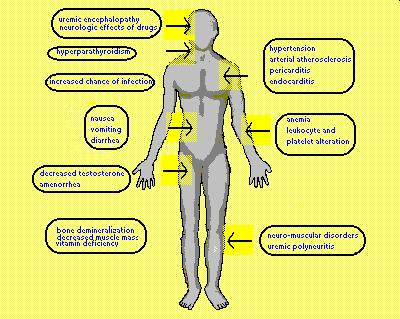Health Risks of Kidney Failure
As of 1993, over 150,000 people are on dialysis (Gutch, ix). The focus today is not only on
improving dialysis equipment and procedures, but to better understand the
patient aspects of renal failure. Kidney failure has many causes including infections, cancer, and polycystic
disease. End stage renal failure is characterized by less than 15-20% of normal
nephron function that results in the accumulation of hazardous waste products.
The state of kidney failure is termed uremic syndrome and includes a variety of
symptoms. The symptoms may include:
Effects on Water and Electrolyte Balance
reduced total body potassium
slightly increased sodium level
higher proportion of extracellular fluid
Cardiovascular Effects
increased chance of coronary artery disease, stroke, and peripheral
artery disease
Metabolic Effects
abnormal glucose metabolism
elevated lipoprotein level
decrease in essential polypeptides
Anemia and reduced white blood cell count
Increased risk of infection due to malnutrition and immune system
defects
Gastrointestinal Effects
gastrointestinal bleeding
Neurologic Effects
fatigue, anxiety, depression
burning or weakness in the muscles of the limbs
Skeletal Changes
osteitis fibrosa and osteomalacia
bone pain and increased risk of fracture
All of the above symptoms can be controlled with adequate dialysis. In order to
minimize the occurrence of these syptoms, it is important that dialysis patients
receive the proper dialyis treatment. Models such as the one developed in this
site can be used as a tool to investigate the amount of dialysis required. The
measure of dialysis effectiveness is commonly the urea concentration. Increased
urea concentration correlates well with an elevated level of other waste
products that create the symptoms listed above and illustrated in the diagram
below.
It is also important for people with
kidney disease that are not on dialysis to understand the considerations they
must give to these health risks. If some kidney function is present, monitoring
diet and exercise level may help in alleviating some of these symptoms.


